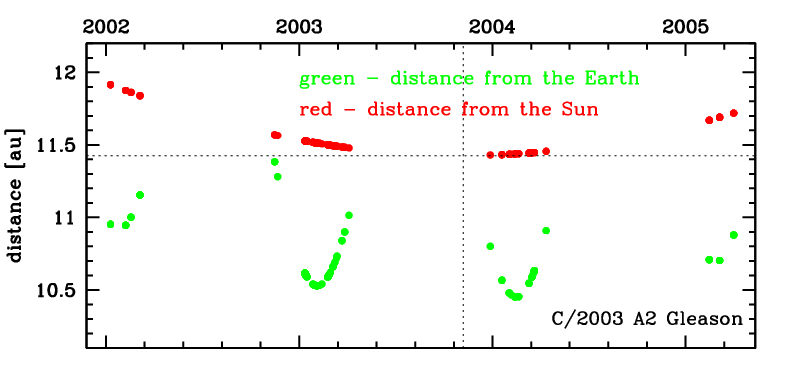C/2003 A2 Gleason
more info
Comet C/2003 A2 was discovered on 10 January 2002 by Arianna E. Gleason using the Spacewatch II telescope at the Kitt Peak National Observatory when the comet was a year and 10 months before its perihelion passage. This comet was observed 3.2 yr during its four oppositions in a narrow range of heliocentric distances: 11.9 au – 11.43 au (perihelion) – 11.70 au. However, there is a long pause around perihelion lasting over 7 months (from 1 April to 11 November of 2002).
Comet had its closest approach to the Earth on 14 February 2004 (10.451 au).
This Oort spike comet suffers minor planetary perturbations during its passage through the planetary system that lead to a more tight future orbit (see future barycentric orbit).
See also Królikowska and Dybczyński 2017.
Comet had its closest approach to the Earth on 14 February 2004 (10.451 au).
This Oort spike comet suffers minor planetary perturbations during its passage through the planetary system that lead to a more tight future orbit (see future barycentric orbit).
See also Królikowska and Dybczyński 2017.
| solution description | ||
|---|---|---|
| number of observations | 149 | |
| data interval | 2002 01 08 – 2005 03 31 | |
| data type | significantly more measurements before perihelion (PRE+) | |
| data arc selection | entire data set (STD) | |
| range of heliocentric distances | 11.9 au – 11.43 au (perihelion) – 11.7 au | |
| detectability of NG effects in the comet's motion | NG effects not determinable | |
| type of model of motion | GR - gravitational orbit | |
| data weighting | YES | |
| number of residuals | 297 | |
| RMS [arcseconds] | 0.53 | |
| orbit quality class | 1a | |
| orbital elements (barycentric ecliptic J2000) | ||
|---|---|---|
| Epoch | 2321 06 23 | |
| perihelion date | 2003 11 04.29905006 | ± 0.01505245 |
| perihelion distance [au] | 11.42176039 | ± 0.00005561 |
| eccentricity | 0.99846734 | ± 0.00002902 |
| argument of perihelion [°] | 346.664908 | ± 0.000555 |
| ascending node [°] | 154.525849 | ± 0.000154 |
| inclination [°] | 8.068556 | ± 0.000058 |
| reciprocal semi-major axis [10-6 au-1] | 134.19 | ± 2.54 |
| file containing 5001 VCs swarm |
|---|
| 2003a2a5.bpl |

